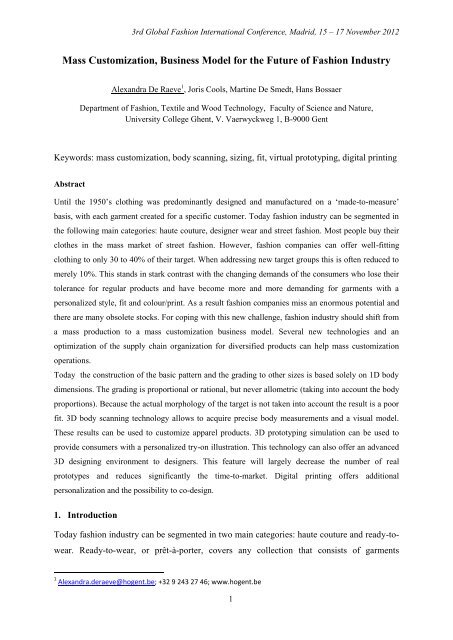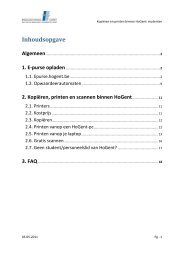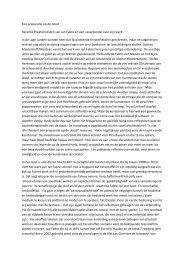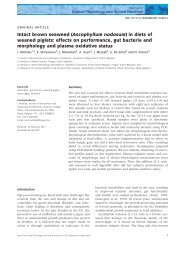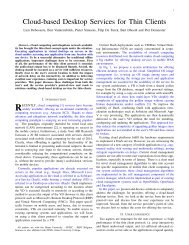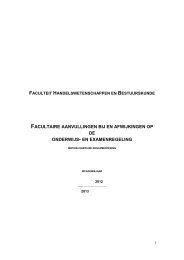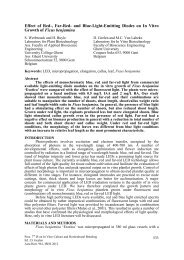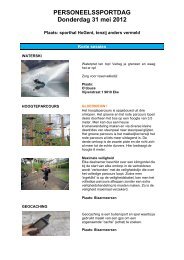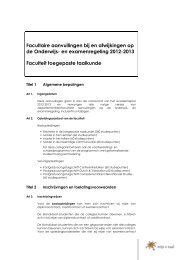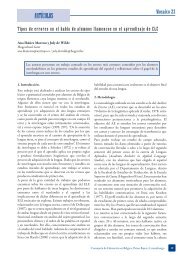Mass Customization, Business Model for the Future of Fashion ...
Mass Customization, Business Model for the Future of Fashion ...
Mass Customization, Business Model for the Future of Fashion ...
You also want an ePaper? Increase the reach of your titles
YUMPU automatically turns print PDFs into web optimized ePapers that Google loves.
3rd Global <strong>Fashion</strong> International Conference, Madrid, 15 – 17 November 2012<strong>Mass</strong> <strong>Customization</strong>, <strong>Business</strong> <strong>Model</strong> <strong>for</strong> <strong>the</strong> <strong>Future</strong> <strong>of</strong> <strong>Fashion</strong> IndustryAlexandra De Raeve 1 , Joris Cools, Martine De Smedt, Hans BossaerDepartment <strong>of</strong> <strong>Fashion</strong>, Textile and Wood Technology, Faculty <strong>of</strong> Science and Nature,University College Ghent, V. Vaerwyckweg 1, B-9000 GentKeywords: mass customization, body scanning, sizing, fit, virtual prototyping, digital printingAbstractUntil <strong>the</strong> 1950’s clothing was predominantly designed and manufactured on a ‘made-to-measure’basis, with each garment created <strong>for</strong> a specific customer. Today fashion industry can be segmented in<strong>the</strong> following main categories: haute couture, designer wear and street fashion. Most people buy <strong>the</strong>irclo<strong>the</strong>s in <strong>the</strong> mass market <strong>of</strong> street fashion. However, fashion companies can <strong>of</strong>fer well-fittingclothing to only 30 to 40% <strong>of</strong> <strong>the</strong>ir target. When addressing new target groups this is <strong>of</strong>ten reduced tomerely 10%. This stands in stark contrast with <strong>the</strong> changing demands <strong>of</strong> <strong>the</strong> consumers who lose <strong>the</strong>irtolerance <strong>for</strong> regular products and have become more and more demanding <strong>for</strong> garments with apersonalized style, fit and colour/print. As a result fashion companies miss an enormous potential and<strong>the</strong>re are many obsolete stocks. For coping with this new challenge, fashion industry should shift froma mass production to a mass customization business model. Several new technologies and anoptimization <strong>of</strong> <strong>the</strong> supply chain organization <strong>for</strong> diversified products can help mass customizationoperations.Today <strong>the</strong> construction <strong>of</strong> <strong>the</strong> basic pattern and <strong>the</strong> grading to o<strong>the</strong>r sizes is based solely on 1D bodydimensions. The grading is proportional or rational, but never allometric (taking into account <strong>the</strong> bodyproportions). Because <strong>the</strong> actual morphology <strong>of</strong> <strong>the</strong> target is not taken into account <strong>the</strong> result is a poorfit. 3D body scanning technology allows to acquire precise body measurements and a visual model.These results can be used to customize apparel products. 3D prototyping simulation can be used toprovide consumers with a personalized try-on illustration. This technology can also <strong>of</strong>fer an advanced3D designing environment to designers. This feature will largely decrease <strong>the</strong> number <strong>of</strong> realprototypes and reduces significantly <strong>the</strong> time-to-market. Digital printing <strong>of</strong>fers additionalpersonalization and <strong>the</strong> possibility to co-design.1. IntroductionToday fashion industry can be segmented in two main categories: haute couture and ready-towear.Ready-to-wear, or prêt-à-porter, covers any collection that consists <strong>of</strong> garments1 Alexandra.deraeve@hogent.be; +32 9 243 27 46; www.hogent.be1
3rd Global <strong>Fashion</strong> International Conference, Madrid, 15 – 17 November 2012produced in volume – distinct from <strong>the</strong> one-<strong>of</strong>f garments in haute couture and is divided indesigner wear and street fashion. RTW can be traced back to <strong>the</strong> beginning <strong>of</strong> <strong>the</strong> 20 thcentury, following <strong>the</strong> Industrial Revolution and <strong>the</strong> introduction <strong>of</strong> <strong>the</strong> sewing machine. In<strong>the</strong> beginning it relied on Paris couture and highly skilled dressmakers would copy designs.Although produced starting from standardized sizes it was up until <strong>the</strong> 1950’s predominantlydesigned and manufactured on a ‘made-to-measure’ base, with each garment created <strong>for</strong> aspecific customer. In <strong>the</strong> 1970’s and 1980’s <strong>the</strong> market became saturated with basic productsfrom Marks and Spencer, C&A and o<strong>the</strong>r high street chain stores. In recent yearsglobalization and a number <strong>of</strong> socio-economical and technical trends have greatly changed <strong>the</strong>demands <strong>of</strong> <strong>the</strong> consumers and have created a need <strong>for</strong> conspicuous and customized design.GlobalizationWith globalization, <strong>the</strong> textile and clothing industry in Europe faces competition from lowwagecountries, especially where it comes to <strong>the</strong> delivery <strong>of</strong> large volumes and basicgarments. These products are above all most <strong>of</strong>ten produced in places where environmentalregulations are not demanding and <strong>of</strong>ten violated without consequences. The environmentalcosts that have to be paid in Europe are <strong>the</strong>re<strong>for</strong>e experienced as an additional disability.Socio-economic and technical trendsFor thousands <strong>of</strong> years, clothing has consisted only <strong>of</strong> a number <strong>of</strong> layers providing warmthand protection beyond our natural skin. Today <strong>the</strong> textile and fashion industry is challenged torespond to <strong>the</strong> demands <strong>of</strong> our modern society obsessed with risks, thrilled by experiences,cocooned by well-being, obliged to achieve sustainability, enslaved to low prices,individualistic and self-indulgent.During <strong>the</strong> period <strong>of</strong> <strong>the</strong> last 50 years a new generation <strong>of</strong> innovative fibres, textile materialsand products was created. Many <strong>of</strong> <strong>the</strong>se fabrics show high per<strong>for</strong>mance and have multifunctionalpurposes, such as rainwear that can be fashionable and protect against rain, windand cold or protective garments providing ballistic, chemical, microbial and flame protection.These functions are added to fabrics by using fibres that have inherent functional properties orby coating or laminating a polymer layer that provides <strong>the</strong> required function(s). Most polymersystems that were built-in in one way or ano<strong>the</strong>r in textiles during <strong>the</strong> last century ensureelementary functions such as waterpro<strong>of</strong>ness, chemical resistance, breathability, flameretardancy, anti-microbiological or antistatic properties, etc. These systems are all passivesystems. At <strong>the</strong> dawn <strong>of</strong> <strong>the</strong> new millennium (September 11, 2001) society experienced a2
3rd Global <strong>Fashion</strong> International Conference, Madrid, 15 – 17 November 2012major change in its way <strong>of</strong> life and became more or less obsessed with safety and quality <strong>of</strong>life. Passive polymer systems are <strong>of</strong>ten no longer satisfying, <strong>the</strong>y must be intelligent and mustsense and adapt to environmental stimuli to ensure an optimisation <strong>of</strong> <strong>the</strong> behaviour <strong>of</strong> <strong>the</strong>textile <strong>the</strong>y are built-in. For several years <strong>the</strong> development <strong>of</strong> active systems was only <strong>of</strong>importance to <strong>the</strong> military and space industry. Nowadays fire fighters, sportsmen, businesspeople, elderly people, etc. all want to benefit from this revolution in materials <strong>for</strong> <strong>the</strong>irindividual specific needs (customized products). Personalization <strong>of</strong> products requires a greaterdegree <strong>of</strong> customization than choosing from a range <strong>of</strong> alternatives, <strong>of</strong>ten a personalcontribution is required, making an emotional connection with <strong>the</strong> product (eg. T-shirt printedwith a picture <strong>of</strong> your own child). (Don A. Norman, Emotional design: why we love (or hate)everyday things - Basic Books 2003).The development and <strong>the</strong> marketing <strong>of</strong> <strong>the</strong>se customized products is subject to an en<strong>for</strong>cedmarket orientation, to textile materials with high levels <strong>of</strong> quality, beauty and per<strong>for</strong>mancecharacteristics, to more flexible small batch oriented manufacturing processes that allow botha better consumer orientation (mass customization) and high levels <strong>of</strong> quality andper<strong>for</strong>mance <strong>of</strong> <strong>the</strong> garment and finally to an intense cooperation within <strong>the</strong> textile/clothingvalue chain.This challenge involves major changes in managerial attitude: The introduction <strong>of</strong> <strong>the</strong> four key elements <strong>of</strong> strategic innovation:o Value innovation: <strong>of</strong>fering <strong>the</strong> customer a product or service that he perceivesas valuable and new;o New market creation: stop focussing on <strong>the</strong> same market segments as <strong>the</strong>ircompetitors, but instead attract new types <strong>of</strong> customers. New markets can becreated within existing industries by identifying unserved customer segments,targeting new combinations <strong>of</strong> existing customer segments, or redefining how<strong>the</strong> market is segmented (Markides, 1997);o Go-to-market innovation: finding a novel approach <strong>for</strong> marketing products orservices;o Competitive disruption: deviating from <strong>the</strong> structure existing in <strong>the</strong> fashionindustry and adopt an entirely new business model. The availability <strong>of</strong> capital and <strong>the</strong> will to take risks in developing products andprocesses <strong>for</strong> which <strong>the</strong> market is still in a developing phase.3
3rd Global <strong>Fashion</strong> International Conference, Madrid, 15 – 17 November 2012The introduction <strong>of</strong> quick response strategies that speed up <strong>the</strong> flow <strong>of</strong> in<strong>for</strong>mationand merchandise between retailers and manufacturers <strong>of</strong> apparel and textiles, alldriven by <strong>the</strong> consumer.The receptiveness <strong>for</strong> an adequate circulation <strong>of</strong> knowledge across <strong>the</strong> entire supplychain and along <strong>the</strong> different layers <strong>of</strong> organisation (industry, research and education)<strong>for</strong> each link in <strong>the</strong> supply chain and layer has its own specific expertise andrelevance.2. <strong>Mass</strong> customizationWithin <strong>the</strong> Western society consumers underline <strong>the</strong>ir personality and status through <strong>the</strong>purchase <strong>of</strong> certain consumer goods. Tuned cars are a clear example but eccentric garmentsare also used to move from <strong>the</strong> crowd. Although <strong>the</strong> consumer attaches great importance topersonalized items, research has shown that consumers do not want to pay significantly more.Personalized items are mainly <strong>the</strong> result <strong>of</strong> traditional crafts, but due to high labour costs, <strong>the</strong>market <strong>for</strong> customized products remains a (small) niche market. Companies that are obligedto deliver customized products because <strong>of</strong> <strong>the</strong> sector in which <strong>the</strong>y operate, or by a changedmarket situation are faced with <strong>the</strong> same challenge: deliver customized products at a pricelevel similar to that <strong>of</strong> mass production.For several decades a business model has been developed that tries to <strong>of</strong>fer a solution to <strong>the</strong>paradigm customization at mass production cost : mass customization.A mass production environment is organized in a way to efficiently manufacture and sellproducts, preferably in large numbers.Within a mass customization oriented company <strong>the</strong> production is started after <strong>the</strong> customerhas placed his specific order. Here <strong>the</strong> supply chain must be organized in such a way that <strong>the</strong>product can be delivered at a mass production price.<strong>Mass</strong> customization distinguishes itself from handicraft by production within an industrialsetting at maximum efficiency (and low production costs). <strong>Mass</strong> customization is applicableto both goods and services. It has many facets and one <strong>of</strong> <strong>the</strong> biggest misconceptions aboutmass customization is that <strong>the</strong> manufacturer grants total freedom to <strong>the</strong> consumer to create aproduct entirely according to his specific wishes. This is <strong>of</strong> course only possible in a verylimited number <strong>of</strong> cases.4
3rd Global <strong>Fashion</strong> International Conference, Madrid, 15 – 17 November 2012<strong>Customization</strong> may cover one or more aspects <strong>of</strong> <strong>the</strong> product or service and this in varyingdegrees. Between pure standardization and customization is a full range <strong>of</strong> options: Pure standardization: <strong>the</strong> customer can only choose from a full pre-defined range. Segmented standardization: Products are customized <strong>for</strong> each segment. An example is<strong>the</strong> automobile industry where cars destined <strong>for</strong> <strong>the</strong> U.S. are standard equipped with anautomatic transmission and cars destined <strong>for</strong> <strong>the</strong> European market with a manualgearbox. Customized standardization: <strong>the</strong> customer can choose from a number <strong>of</strong> predefinedoptions. For a car, <strong>the</strong> customer can <strong>for</strong> example choose <strong>the</strong> body colour, <strong>the</strong> colourand composition <strong>of</strong> <strong>the</strong> upholstery and <strong>the</strong> type <strong>of</strong> <strong>the</strong> engine. Tailored customization: <strong>the</strong> customer can choose a number <strong>of</strong> parameters. An exampleis a men’s shirt <strong>of</strong>fering <strong>the</strong> possibility choose <strong>the</strong> type <strong>of</strong> collar and cuff, <strong>the</strong> number<strong>of</strong> breast pockets, <strong>the</strong> length <strong>of</strong> <strong>the</strong> sleeves, etc. Full customization applied to <strong>the</strong> above example would allow <strong>the</strong> customer to alsodesign <strong>the</strong> style and <strong>the</strong> print or weave.<strong>Mass</strong> customization <strong>the</strong>re<strong>for</strong>e <strong>of</strong>fers a wide range <strong>of</strong> possibilities. To successfully implementthis business model, companies must make <strong>the</strong> right trade-<strong>of</strong>f between full standardizationand full customization. When a product is highly standardized, it <strong>of</strong>fers no benefit to <strong>the</strong>customer, if <strong>the</strong> customization is too far-reaching, production can be too complicated (tooexpensive, too long delivery time, ...). It is not enough to customize <strong>the</strong> product, but <strong>the</strong>production process must also be adapted. This can be reached by paying attention to elementssuch as setup times, automation, production speed, ...The concrete implementation <strong>of</strong> <strong>the</strong> paradigm "mass customization at mass production price"can <strong>the</strong>re<strong>for</strong>e be very diverse. On <strong>the</strong> one hand, <strong>the</strong> nature <strong>of</strong> <strong>the</strong> product will limit <strong>the</strong> number<strong>of</strong> options. On <strong>the</strong> o<strong>the</strong>r hand, <strong>the</strong> possibilities <strong>for</strong> customization are determined by <strong>the</strong>company itself.Many companies wish to apply <strong>the</strong> mass customization business model to keep <strong>the</strong>ir marketshares. Some do this on <strong>the</strong>ir own initiative but most will generally rely on externalconsultants. The interpretation <strong>of</strong> <strong>the</strong> mass customization model is not only sector-specific,but even company-specific (and even within one company a different interpretation can begiven to <strong>the</strong> multiple product lines). When introducing mass customization, companies needsupport from an organization that is both familiar with mass customization and has a good5
3rd Global <strong>Fashion</strong> International Conference, Madrid, 15 – 17 November 2012understanding <strong>of</strong> <strong>the</strong> industry, its raw materials, its semi-finished products and its productionprocesses.In <strong>the</strong> clothing industry, collections are developed almost exclusively on <strong>the</strong> basis <strong>of</strong> <strong>for</strong>ecastdata. The large uncertainty in estimating <strong>the</strong> demand means that certain collections never find<strong>the</strong>ir way to <strong>the</strong> customer, while <strong>for</strong> o<strong>the</strong>r collections <strong>the</strong> demand is greater than supply. Whenmany collections are <strong>of</strong>fered, <strong>the</strong> consequence is that <strong>the</strong> production is distributed over manysmall runs that just meet or are below <strong>the</strong> EOQ (economic order quantity), that many switchoversin production are needed and that <strong>the</strong> number <strong>of</strong> SKUs (stock keeping units ) and totalinventories increase. The turnover that one gets with a limited number <strong>of</strong> successful articles is<strong>of</strong>ten largely consumed by <strong>the</strong> losses <strong>of</strong> less successful articles.Within a mass customization based business model this problem is avoided by manufacturingonly those garments that are effectively ordered/desired.Apparel is <strong>the</strong> perfect product to address <strong>the</strong> three dimensions <strong>of</strong> personalization: fit (style,dimensions, sizes), functionality and design (taste, shape). Products that require adjusting tovarious physical sizes and functionalities, can be sold at higher prices than products that arepersonalized by merely adjusting <strong>the</strong> colour or print.A mass-based clothing company does not have <strong>the</strong> structure to supply an individual orderwithin an acceptable delivery time and at a mass production price. The needs <strong>of</strong> <strong>the</strong> apparelindustry are mainly in <strong>the</strong> context <strong>of</strong> specific challenges regarding flexibility, results, costcontrol, process control, customer value, speed <strong>of</strong> change and innovation, translating <strong>the</strong>product message through a customized client interface.A SWOT analysis, conducted at <strong>the</strong> University College Ghent in <strong>the</strong> fall <strong>of</strong> 2006, with 53experts from <strong>the</strong> textile and clothing sector brought some bottlenecks to <strong>the</strong> front including alack <strong>of</strong> communication and vision within <strong>the</strong> value chain <strong>of</strong> textiles and clothing, <strong>the</strong>excessive focus on mass production and <strong>the</strong> lack <strong>of</strong> knowledge <strong>of</strong> <strong>the</strong> possibilities <strong>of</strong>fered byICT. <strong>Mass</strong> customization relies strongly on new 'enabling technologies', in which ICT ando<strong>the</strong>r digital technologies are important.6
3rd Global <strong>Fashion</strong> International Conference, Madrid, 15 – 17 November 201291 87 89 breast71 68 70 waist95 92 94 hipFig. 2 One size, three body shapesFig. 3 Right size, wrong fit (source SHARP Dummies)A good fit is also one <strong>of</strong> <strong>the</strong> main parameters to obtain adequate <strong>the</strong>rmophysiological com<strong>for</strong>tand protection. In <strong>the</strong> development phase <strong>of</strong> clothing manufacturers used to focus on <strong>the</strong>8
3rd Global <strong>Fashion</strong> International Conference, Madrid, 15 – 17 November 2012physical (strength, elasticity, insulation, air permeability, …) and sensory properties (hand,colour, smell) <strong>of</strong> <strong>the</strong> textile materials in order to obtain <strong>the</strong> required com<strong>for</strong>t level. The twoyearresearch project ‘Com<strong>for</strong>tex’ which was conducted by <strong>the</strong> authors has proven thattechnical components such as clothing design, assembly techniques and especially fit andsizing are <strong>for</strong> over 50 % responsible <strong>for</strong> wear com<strong>for</strong>t and ergonomics <strong>of</strong> <strong>the</strong> finishedgarment.With <strong>the</strong> introduction <strong>of</strong> mass production and ready-to-wear garments, <strong>the</strong>re was no longerattention <strong>for</strong> a personal fit. Different manufacturers standardized sizes each in <strong>the</strong>ir ownmanner. A study <strong>of</strong> Just Style 2 indicates that due to <strong>the</strong> diversity <strong>of</strong> people and in many cases<strong>the</strong> poor quality <strong>of</strong> body measurement tables most brands can <strong>of</strong>fer well-fitting clothing toonly 30 – 40 % <strong>of</strong> <strong>the</strong>ir target group. When <strong>the</strong>se companies explore new markets, thisnumber is in some cases reduced to a mere 10 %. The first years some brands survive with <strong>the</strong>help <strong>of</strong> <strong>the</strong>ir innovativeness and/or design, but in <strong>the</strong> subsequent years a proper size range andfit take <strong>the</strong> upper hand in <strong>the</strong> decision to purchase. The clothing industry in Belgium and o<strong>the</strong>rcountries is convinced that size range and fit are a real advantage to compete with cheapimported products 3 . This applies to both companies who distribute <strong>the</strong>ir own brands as tocontractors. In <strong>the</strong> case <strong>of</strong> protective clothing and sportswear a good fit is a must to guarantee<strong>the</strong> safety and per<strong>for</strong>mance ability <strong>of</strong> <strong>the</strong> person.Clothing sizes and fit are difficult concepts to explore and analyze as <strong>the</strong> relationship between<strong>the</strong> human body and <strong>the</strong> garment is complex and <strong>of</strong>ten two-fold. The current methods tocreate sizes and to assess <strong>the</strong> fit are based on <strong>the</strong> dimensions <strong>of</strong> <strong>the</strong> ‘ideal’ customer being represented by a single fitmodel adapted to o<strong>the</strong>r sizes by applying grading rules to <strong>the</strong> basic pattern <strong>for</strong> <strong>the</strong>proportional increases and decreases and visual and two-dimensional (in length and width) evaluation comparing linear clothingmeasurements and body measurements.Although <strong>the</strong>se methods are useful to evaluate simple fitting outcomes, <strong>the</strong>y are not suited toassess <strong>the</strong> complexity <strong>of</strong> <strong>the</strong> versatile relationship between <strong>the</strong> body and clothing <strong>of</strong> a largenumber <strong>of</strong> customers with an extended variety <strong>of</strong> body shapes within one size.2 Just-style.com briefings service (July 2010), Sizing a headache <strong>for</strong> glogalizing apparel industry3 Karryn Miller (2010), Studying body size is key to market fit, Just-style.com briefings service9
3rd Global <strong>Fashion</strong> International Conference, Madrid, 15 – 17 November 2012It is <strong>the</strong>re<strong>for</strong>e not surprising that a study conducted by Kurt Salmon Associates indicates that50 percent <strong>of</strong> women claim not to find clo<strong>the</strong>s that fit. For jeans this may be up to 64 %.Moreover, poorly fitting protective clothing and sportswear involve serious risks <strong>for</strong> <strong>the</strong>wearer. The functioning and per<strong>for</strong>mance ability <strong>of</strong> <strong>the</strong> wearer is as well adversely affected.O<strong>the</strong>r studies showed that 50 percent <strong>of</strong> purchases through catalogs are sent back because <strong>of</strong>problems with <strong>the</strong> fit.Companies today are using outdated one-dimensional mean values and percentiles. These dataare so deceptive that even with <strong>the</strong> best intentions errors are included from <strong>the</strong> start in <strong>the</strong>product specifications. Moreover, 1D measurement data are blind. They are meaninglessregarding <strong>the</strong> constitution <strong>of</strong> <strong>the</strong> measured individuals. When basic patterns are graded tolarger and smaller sizes and 3D data <strong>of</strong> <strong>the</strong> body are not available, this is mostly an ‘educatedguess’ and even more faults are built in. An alternative approach would be to improve eachcompany’s unique sizing system to fit more people within <strong>the</strong>ir target market or in o<strong>the</strong>rwords to mass customize <strong>the</strong>ir size charts. An existing sizing system could be improved in <strong>the</strong>following ways:a) change <strong>the</strong> base size specifications to correspond more closely to <strong>the</strong> proportions <strong>of</strong><strong>the</strong> majority <strong>of</strong> <strong>the</strong> people in <strong>the</strong> target market;b) develop a new sizing system that may have six or eight sizes that are based on targetmarket body shape measurements ra<strong>the</strong>r than on proportional fit assumptions.This is logistically and financially feasible using <strong>the</strong> 3D body scanner and computer-aideddesign (CAD) grading systems.4. Methodology4.1 Determining <strong>the</strong> body dimensions <strong>of</strong> <strong>the</strong> Belgian population and development <strong>of</strong>database, standard size charts and frequency tablesFirst 0.05 % <strong>of</strong> <strong>the</strong> Belgian population, except <strong>for</strong> pregnant women and children under three,will be measured. This number is <strong>the</strong> same as <strong>the</strong> previous measurement campaign from 1990,but higher than in o<strong>the</strong>r countries that conducted a sizing survey (France, 11.562measurements made in 2006 (0,02 % <strong>of</strong> <strong>the</strong> population); Germany, 13.362 measurements in2008 (0,016 %); Ne<strong>the</strong>rlands, 2000 measurements <strong>of</strong> 18-65 year olds in 2008 (0,04 %) andGreat-Britain, 11.000 measurements in 2004 (0,02 %). The scanning devices will be a TelmatSYMCAD 3D body scanner and a TC² body scanner using structured white light.10
3rd Global <strong>Fashion</strong> International Conference, Madrid, 15 – 17 November 2012We started defining <strong>the</strong> measurement procedure and a socio-demographic survey.All measurements and in<strong>for</strong>mation about <strong>the</strong> subjects will be stored in a database.The statistical analysis <strong>of</strong> anthropometric data: mean, percentiles, standard deviation,correlation, graphic charts, should allow us to make up <strong>the</strong> standard body size charts andfrequency tables. We will consider 5 age groups in <strong>the</strong> standard charts: 3-13 years, 14-25years, 26-45 years, 46-64 years and 65 +, both men and women. These charts can <strong>the</strong>n befur<strong>the</strong>r divided into clothing that completely covers <strong>the</strong> body, covering above <strong>the</strong> waist andbelow <strong>the</strong> waist. This will be in harmony with EN 13402 (CEN/TC 248/WG 10: sizedesignation system <strong>for</strong> clothing). Existing size tables are <strong>of</strong> <strong>the</strong> 1D type. A primary dimensionis chosen based on <strong>the</strong> type <strong>of</strong> clothing (eg. waist circumference). Adjacent intervals areprovided (70-74, 74-78, 78-82, …). The margins are chosen in a way that clothing iscom<strong>for</strong>table enough without being too broad. The expected values <strong>of</strong> certain secondaryparameters (hip circumference, chest circumference, …) are also given in intervals. Thechoice <strong>of</strong> primary and secondary dimensions is decisive to determine <strong>the</strong> percentage <strong>of</strong> <strong>the</strong>target group that can be dressed appropriate. In current size tables intervals do not overlap. Inreality this is only possible if all body types within <strong>the</strong> population are identical except ascaling factor. This is obviously not <strong>the</strong> case. For each class <strong>of</strong> waist circumference we mustallow a variation <strong>of</strong> <strong>the</strong> secondary dimension that partially covers variations <strong>of</strong> <strong>the</strong> waistcircumference <strong>of</strong> neighboring classes. Proposals will be made which will <strong>for</strong>m a more specificclassification and allow improved patterns.Comparing <strong>the</strong> results <strong>of</strong> <strong>the</strong> socio-demographic survey with <strong>the</strong> size data will allow us todetermine whe<strong>the</strong>r <strong>the</strong>re is correlation between <strong>the</strong> two. We will also be able to set up sizecharts <strong>for</strong> specific target groups. This will bring <strong>the</strong> possibilities and potential <strong>of</strong> masscustomization closer to <strong>the</strong> manufacturers.4.2 Study <strong>of</strong> morphotypesSecond, <strong>the</strong> body shapes will be studied. We will do this by Principle Component Analysis.The population will be divided into five or more body types <strong>for</strong> men and women that willcover 80 % <strong>of</strong> <strong>the</strong> population. This should give us also a good view on <strong>the</strong> most commonabnormalities in a body.11
3rd Global <strong>Fashion</strong> International Conference, Madrid, 15 – 17 November 20124.3 Development <strong>of</strong> an allometric grading techniqueNext an allometric grading technique will be developed.Grading is a process used to produce clothing in a certain size range. For this, at certain pointscalled cardinal points, dimensional increases or decreases are applied to <strong>the</strong> pattern to obtainlarger or smaller sizes. To establish a relationship between body size and grading technique,<strong>the</strong> cardinal points must correspond to a landmark on <strong>the</strong> body which is a horizontal orvertical measurement (grading is done according an XY coordinate system). Landmarks are<strong>the</strong> endpoints <strong>of</strong> a measurement. In proportional grading techniques we note that <strong>the</strong> cardinalpoints do not always correspond to landmarks, <strong>the</strong> breastpoint remains in <strong>the</strong> same position<strong>for</strong> all sizes, <strong>the</strong> increases and decreases are conducted with constant rate and all patternpieces become larger as <strong>the</strong> size increases. Even when using a rational grading system thattakes <strong>the</strong> proportions in <strong>the</strong> basic pattern construction into account, <strong>the</strong> body shape is notconsidered. When <strong>the</strong> actual size differs more from <strong>the</strong> basic size in which <strong>the</strong> pattern wasmade up, it inevitably leads to a poor fit. Body measurements do not increase or decreaseproportionally as a person gains or loses weight.At each cardinal point <strong>of</strong> a pattern a landmark will be assigned. This measurement will ei<strong>the</strong>rbe horizontal or vertical. A landmark may be connected to only one cardinal point. Thesepoints will be graded to <strong>the</strong> actual body proportions and not proportional.4.4 Processing scan results into usable avatarsFinally <strong>the</strong> 3D volumes will be processed into a usable avatar <strong>for</strong> virtual prototyping to assess<strong>the</strong> fit. This will be an improvement to <strong>the</strong> parametric avatars available in 3D prototypings<strong>of</strong>tware which only permit to adapt <strong>the</strong> size, but not <strong>the</strong> shape. Basic patterns can thus beautomatically adjusted to customized patterns which will strongly reduce lead time <strong>for</strong>product development.This will also create new opportunities <strong>for</strong> virtual fit <strong>of</strong> apparel. Today <strong>the</strong> growth <strong>of</strong> onlineretailing <strong>of</strong> apparel is limited by lack <strong>of</strong> in<strong>for</strong>mation on clothing fit. The development <strong>of</strong> fitvisualization, size selection and design style selection technologies can help provide thisin<strong>for</strong>mation.My Virtual <strong>Model</strong> (MVM) provides a website which allows <strong>the</strong> user to create a digital modelor avatar <strong>of</strong> <strong>the</strong>mselves. A range <strong>of</strong> aes<strong>the</strong>tic features such as hairstyle and skin colour areavailable to create a resembling avatar. The parametric avatar is created by means <strong>of</strong> a12
3rd Global <strong>Fashion</strong> International Conference, Madrid, 15 – 17 November 2012computer algorithm using simple body measurements and <strong>the</strong> user’s perception <strong>of</strong> <strong>the</strong>ir bodyshape. This avatar can be ‘dressed’ with digital garments representing <strong>the</strong> retailer’s collectionto give <strong>the</strong> consumer a virtual presentation <strong>of</strong> how he or she might look in <strong>the</strong> outfit.Ano<strong>the</strong>r aid to select well-fitting clothing is automated size selection based on self-measuredbody measurements. However, many people have difficulty manipulating a tape measure.Comparing measurements <strong>of</strong> one person taken by different persons can expose differences asmuch as 7.5 centimeters. Also, both systems take no account <strong>of</strong> <strong>the</strong> exact morphology <strong>of</strong> <strong>the</strong>customer so <strong>the</strong> actual fit on <strong>the</strong> real customer is very <strong>of</strong>ten only mediocre.Avatars from 3D scans are extremely detailed and personal compared to a parametric avatarand can capture exact body proportions and posture.These models can also be used in an intelligent fashion design support system <strong>for</strong> suggesting<strong>the</strong> most appropriate decision about a new design style and its accordance with specific bodyshapes towards a specific fashion <strong>the</strong>me. Moreover, in <strong>the</strong> same system, <strong>the</strong> differencesbetween various body shapes and between various garment styles can be quantitativelycomputed and analyzed. For designers, this treatment is significant <strong>for</strong> understanding relationsbetween body shapes and styles and identifying <strong>the</strong> most relevant garment design <strong>for</strong> aspecific consumer.5. Objectives5.1 Technological objectivesThe primary technological objectives <strong>of</strong> this project are:1. Providing companies with <strong>the</strong> necessary knowledge to develop styles and patternswhich take <strong>the</strong> body shape into account. This will require a study <strong>of</strong> <strong>the</strong> morphotypes.Several body types will be defined.2. The companies will be taught how to grade <strong>the</strong>ir basic patterns allometric so <strong>the</strong> fit isoptimized.3. Companies will be <strong>of</strong>fered greater insight into <strong>the</strong> far unused potential <strong>of</strong> 2D CADprograms and <strong>the</strong>y will discover <strong>the</strong> potential <strong>of</strong> 3D virtual prototyping.4. Database consisting <strong>the</strong> raw anthropometric data5. Improved size charts13
3rd Global <strong>Fashion</strong> International Conference, Madrid, 15 – 17 November 20125.2 Economic valueThe use <strong>of</strong> 3D body scanners has proven its importance in identifying body size and body<strong>for</strong>m <strong>of</strong> <strong>the</strong> population in different countries like The Ne<strong>the</strong>rlands, Germany, Spain, Britainand France. The project results will allow <strong>the</strong> clothing sector to better adjust its sizes and fitsto <strong>the</strong> respective target groups. This will allow <strong>the</strong>m to significantly increase <strong>the</strong> share <strong>of</strong> <strong>the</strong>target group that can be dressed appropriate from 30-40 % to 50-80 %. The brand loyalty <strong>of</strong><strong>the</strong> consumers will undoubtedly be increased. The results <strong>of</strong> <strong>the</strong> sizing campaign can be usedto impart <strong>the</strong> updated standard body size tables as well as size tables <strong>for</strong> specific targetgroups. These tables can be compared with data from o<strong>the</strong>r 3D sizing campaigns in Europe,America or Asia. Allometric grading rules will allow manufacturers to adapt all sizes better to<strong>the</strong> body shape <strong>of</strong> <strong>the</strong> target. Now, we see that when sizes differ more from <strong>the</strong> size <strong>of</strong> <strong>the</strong> fitmodel, <strong>the</strong> fit gets worse. The time and cost to achieve a good prototype will be halved.The project results will also be supportive <strong>for</strong> companies seeking new markets or businessmodels and <strong>the</strong> retail business. The results can be very helpful in preparing a configurator <strong>for</strong> a mass customizationbusiness model. The fashion retailer will be given a better understanding <strong>of</strong> <strong>the</strong> different body shapes.This will enable him to better support <strong>the</strong> end user in choosing clo<strong>the</strong>s that suit his orher body shape. Customer satisfaction will increase. Within <strong>the</strong> clothing industry workwear, protective wear and sportswear are growthmarkets.Between 2004 and 2008 <strong>the</strong> production <strong>of</strong> sports clothing increased by 19.4%. It isexpected to increase with ano<strong>the</strong>r 18.75 % by 2014. The annual growth <strong>for</strong> workwearis estimated between 2.5% and 5%. For <strong>the</strong>se products a good fit can be <strong>of</strong> vitalimportance and / or mean <strong>the</strong> difference between gold or silver. At <strong>the</strong> end <strong>of</strong> <strong>the</strong> season 10 to 15% <strong>of</strong> <strong>the</strong> collection remains on <strong>the</strong> shelves. Aconsiderable part <strong>of</strong> this is simply due to a bad fit. In 2008 21 % <strong>of</strong> SME’s <strong>of</strong>fered products through <strong>the</strong> Internet. In 2009 this wasalready 25 %. 80 percent <strong>of</strong> <strong>the</strong>se SME’s <strong>for</strong>esee an increase in internet sales in <strong>the</strong>coming years. For clothing, <strong>the</strong> increase is smaller than <strong>for</strong> o<strong>the</strong>r products. The causelies in <strong>the</strong> lack <strong>of</strong> adequate size data. The latter are <strong>the</strong> key to <strong>the</strong> growth <strong>of</strong> e-Commerce <strong>for</strong> clothing. 50 percent <strong>of</strong> returned purchases by mail order or over <strong>the</strong>14
3rd Global <strong>Fashion</strong> International Conference, Madrid, 15 – 17 November 2012Internet has its origin in problems with <strong>the</strong> size and fit. Better measurements and fitwill at least halve this figure.Digital printing <strong>of</strong>fers additional personalization and <strong>the</strong> possibility to co-design, thus creatingadditional customer value.5.3 Social valueThe project results will ensure that <strong>the</strong> per<strong>for</strong>mance, safety and wellbeing <strong>of</strong> users ispromoted.Studies already showed that <strong>the</strong> fit, toge<strong>the</strong>r with <strong>the</strong> materials used in sportswear can greatlyaffect per<strong>for</strong>mance <strong>of</strong> athletes (Swift Skin <strong>for</strong> cyclists and skaters and Swift Suit from Nike orFastskin ® from Speedo <strong>for</strong> athletes). The project results will support manufacturers <strong>of</strong>sportswear in <strong>the</strong> development <strong>of</strong> high-per<strong>for</strong>mance sportswear.A common complaint among workers is that <strong>the</strong> personal protective equipment does not fitwell. The project results will contribute in adjusting <strong>the</strong> protective garments to <strong>the</strong> needs anddesires <strong>of</strong> <strong>the</strong> individual wearer meaning work and protective clothing will be worn muchmore consistent so <strong>the</strong>re will be less injuries in case <strong>of</strong> an accident.Workstations can also be designed more ergonomic so that <strong>the</strong> number <strong>of</strong> workers with backpain will diminish and <strong>the</strong>re will be less absenteeism.In most Western countries, <strong>the</strong> population is ageing. Between 2010 and 2020 an increase in<strong>the</strong> number <strong>of</strong> people over 65 with 200,000 and with 300,000 between 2020 and 2030 isexpected (46%). Old age is not what it used to be. Not only do we all age, we age differently.The New Elderly Person is healthier, wealthier, better educated and more assertive than itspredecessor. At an age when <strong>the</strong>ir parents were thinking <strong>of</strong> phasing out quietly, <strong>the</strong> new 55-plus step in <strong>the</strong>ir second adolescence, and <strong>the</strong>y prepare <strong>the</strong>mselves to put <strong>the</strong> crown on <strong>the</strong>irlives. Seniors today have a busy life, <strong>the</strong>y travel and sport. They also want to dress differentlyfrom <strong>the</strong>ir predecessors. They want fashionable, colourful and well-fitting clo<strong>the</strong>s <strong>for</strong> all <strong>the</strong>iractivities. Many seniors are faced with a physique that deviates from <strong>the</strong> standard. This maybe merely due to overweight, but also to eg. kyphosis, lordosis or scoliosis. This implies that<strong>the</strong> fashionable ready-to wear garments <strong>of</strong>fered in <strong>the</strong> stores do not have <strong>the</strong> right fit and donot feel com<strong>for</strong>table. The project results will ensure that <strong>for</strong> this specific target group moreappropriate garments can be developed.15
3rd Global <strong>Fashion</strong> International Conference, Madrid, 15 – 17 November 2012AcknowledgementsThe authors would like to thank <strong>the</strong> Flemish agency <strong>for</strong> innovation by Science and Technology IWT<strong>for</strong> financial support <strong>of</strong> <strong>the</strong> projects ‘Com<strong>for</strong>tex, <strong>the</strong>rmophysiological modeling <strong>of</strong> active wear <strong>for</strong>work, protection and sports’ and ‘Smartfit, research project focused on <strong>the</strong> determination <strong>of</strong> updatedBelgian size tables, defining body types and creating tools that facilitate mass customization,sustainable design and e-commerce’. This paper is part <strong>of</strong> <strong>the</strong> two-year project Smartfit that started inDecember 2011. It has relevant stakeholders, including <strong>the</strong> textile and garment manufacturingfederations Fedustria and Creamoda, <strong>the</strong> Scientific Institute <strong>for</strong> Public Health and over ten SME’s thatagreed to co-finance <strong>the</strong> project.References1. E. Nyssen, J. Cornelis, R. Younckx (1990), Belgische matentabellen voor bovenkleding,Kledingfederatie2. www.DINbelg2005.be, consulted on 25/08/20103. M. Geentjens, Antropometrie, www. gesa.be/antropometrie.pdf, consulted on 20/09/20104. EN 13402 CEN/TC 248/WG 10: size designation system <strong>of</strong> clothing5. http://www.ergonomiesite.be/antropometrie.htm, consulted on 20/09/20106. ISO 8559:1989 Garment Construction and anthropometric surveys – Body dimensions7. S. Alemany (2008), Anthropometric activities in IBV, WEAR Conference, Paris8. K.M. Robinette, S. Blackwell, H. Daanen (2002), Civilian American and European SurfaceAnthropometrie Resource (CAESAR) Final report, Volume 1: Summary9. D. Caple & associates Pty Ltd.(2009), Sizing up Australia: How contemporary is <strong>the</strong>anthropometric data Australian designers use?10. Sizing, a headache <strong>for</strong> globalizing apparel industry (2010), Just Style.com11. K.L. Wuensch (2009), Principal components analysis, core.ecu.edu/psyc/wuenschk/mv/fa/pcaspss.doc12. C. Berger, F. Piller (2003), Customers as co-designers: The miAdidas mass customizationstrategy, IEE Manufacturing Engineer, Vol. 82, 42-4613. F. Piller (2008), Interactive value creation with users and customers, Leading open innovation,Munich: Peter-Pribilla Foundation, 16-2414. F. Piller (2006), <strong>Mass</strong> <strong>Customization</strong> Ein wettbewerbsstrategisches Konzept imin<strong>for</strong>mationszeitalter, Springer e-books15. T. Blecker, G. Friedrich (2006), <strong>Mass</strong> customization: chalenges and solutions, International seriesin operations research & management science, Vol. 8716
3rd Global <strong>Fashion</strong> International Conference, Madrid, 15 – 17 November 201216. Telmat Industry (2009) Apply a special tracking scenario, training course documentation17. C.R. Boër, S. Dulio (2007), <strong>Mass</strong> customization and footwear: myth, salvation or reality?18. G. Da Silveira, D. Borenstein, F.S. Fogliatto (2001), <strong>Mass</strong> customization: Literature review andresearch directions, International Journal <strong>of</strong> Production Economics, 1-1319. C. Shu, P. Xi, Z. Azouz (2007) Consistent parameterization and principal component analysis <strong>of</strong>3D anthropometry data, WEAR Conference, Bannf20. D. Veitch (2007), Life-like apparel mannequins from 3D human data, WEAR Conference, Bannf21. H. Daanen, F. Nennie, M. Rioux (2007), 3D anthropometric data collection, WEAR Conference,Bannf22. K. Robinette (2010), 3-D or not 3-D? Benefits and potential <strong>of</strong> 3D anthropometry, WEARConference, Valencia23. C. Shu (2010), Making 3-D Anthropometric data usable, WEAR Conference, Valencia24. H. Daanen (2010), Evaluation <strong>of</strong> Diital human models, WEAR Conference, Valencia25. D. Veitch (2010), Application <strong>of</strong> anthropometric data to garment sizing and design via innovativeproduct development tools, WEAR Conference, Valencia26. S. Allemany, C. Arnaiz (2010), Anthropometric survey <strong>of</strong> <strong>the</strong> Spanish female population aimed at<strong>the</strong> apparel industry, WEAR Conference, Valencia27. B. Colombier (2010), Anthropometry applied to children products, WEAR Conference, Valencia28. M. Mochimaru (2010), 4D measurement <strong>of</strong> skin movement and its application to garment design,WEAR Conference, Valencia29. http://www.2dix.com/pdf-2011/analysis-<strong>of</strong>-anthropometric-data-data-clothing-pdf.php consultedon 21/01/201130. C. Renfrew, E. Renfrew (2009). Basics <strong>Fashion</strong> Design, Developing a collection. Switzerland:AVA Publishing31. S. Loker, S. Ashdown, K. Schoenfelder (2005), Size-specific analysis <strong>of</strong> body scan data toimprove apparel fit, Journal <strong>of</strong> Textile and Apparel, Technology and Management, vol.4, n° 332. F. Piller, (2009), Handbook <strong>of</strong> research in mass customization & personalization. S. Ashdown, E.Calhoun, L. Lyman-Clarke, Virtual fit <strong>of</strong> apparel on <strong>the</strong> internet: Current technology and futureneeds. Singapore: World Scientific publishing Company33. M. Debruyne, M. Schoovaerts (2006) Innovation outside <strong>the</strong> lab: Strategic Innovation as <strong>the</strong>alternative, Flanders DC Research Report34. J. Bae, T. May-Plumlee (2005) Customer focused textile and apparel manufacturing systems:towards an effective e-commerce model, Journal <strong>of</strong> Textile and Apparel, Technology andManagement, vol. 4, n° 435. L. Wang (2012) Contribution to development <strong>of</strong> an intelligent system <strong>for</strong> supporting personalizedfashion design, Lille, Université Lille 117


